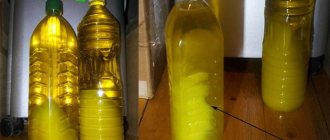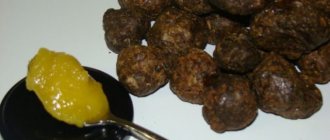Recipes based on coconut oil are rapidly gaining popularity. The scope of its use is very wide - its unique properties are used both in cooking and in medicine and cosmetology.
Source: depositphotos.com
When consumed, coconut oil helps strengthen the immune system and accelerate metabolic processes, has an anti-inflammatory effect and is well absorbed by the body. When used externally, it treats various dermatological diseases and accelerates the healing process of damage. In addition, coconut oil is an excellent natural cosmetic for daily skin and hair care.
Coconut oil is a vegetable oil obtained from coconut shavings (copra).
Given all the benefits, it is important to know how to properly store coconut oil in order to preserve its beneficial properties for as long as possible.
Storing Coconut Oil
Coconut oil
The preservation of this natural product depends on the method of obtaining the oil:
- Refined - obtained by hot pressing the soft contents (milk) of coconut palm fruits, has a transparent consistency, the aroma is weak or absent. The product is cleaned from solid impurities; you can simply store it in a cool place - a closet or refrigerator.
- Unrefined - obtained by first cold pressing in small quantities, and therefore the product costs several times more than refined. This oil has a beautiful golden hue and a bright, pleasant smell of fresh coconut pulp. You can see small pieces of coconut shavings in it. Its beneficial qualities are immeasurably higher: it is used to moisturize the skin of the body and face, contains vitamins and acids necessary for the restoration and rejuvenation of the skin.
Advice! You need to purchase oil in small quantities. The beneficial properties depend on the degree of freshness of the product; the old one won't do much good.
In what container should it be stored?
The main condition required for storage is suitable, correctly selected containers.
It is advisable to give preference to glass, preferably dark in color, as less light enters through it. When purchasing in liquid form, pour the product into a glass jar or bottle with a tight-fitting lid or stopper to prevent air from entering.
Should be stored only in dry, clean jars. To use part of the butter: cut off the entire piece using clean cutlery.
Store coconut oil at home correctly in a dark and dry place, in a cupboard or refrigerator. Permissible temperature range is from +5°C to 25°C. The best containers are dark glass jars.
Where and how to store coconut oil
You need to purchase oil in small quantities.
Safety depends on many factors:
- storage temperatures;
- water vapor content in the air;
- degree of illumination;
- packaging tightness.
The oil product is produced by various manufacturers, the possible storage periods are different (if the sealed packaging is not damaged - up to four years).
Important! The shelf life of the oil in an opened package is approximately one year.
What container to store coconut oil in?
After opening the sealed container, you should decide how and when this product will be used, choose the method and place of storage.
Read more ► Rules for storing food in the refrigerator and freezer, laying out on shelves for long-term storage
If a person expects that this product will be used in several ways (for cooking, for cosmetic purposes, for caring for an animal), then you can divide the oil into several different containers or jars and store them where it will be used.
Unrefined oil contains more nutrients, but has a significantly shorter shelf life than hot-pressed oil.
It could be a closed kitchen shelf, a cabinet in the bathroom, a bedside table in the hallway or bedroom. The ideal container for a high-quality product would be dark glass or porcelain with a screw-on or tight-fitting lid.
These materials do not come into contact with the contents and allow the oil to retain its freshness and beneficial qualities for a long time.
Important rule! It is unacceptable to store the product for a long time in plastic packaging and metal containers.
Temperature
The hardness of coconut oil depends on the ambient temperature: at temperatures above +25 degrees it becomes liquid and fluid, at +10...+25 - jelly-like with a white tint, at temperatures below +10 degrees it resembles frozen fat of white or cream color.
For regular daily use, it is best to store it at a higher temperature : this will be convenient for use.
The permissible temperature ranges from +5 to +25 , and the number of degrees is not as important as the absence of differences and fluctuations. It is temperature fluctuations that lead to premature spoilage.
For regular daily use, it is best to store it at a higher temperature
It is quite acceptable to store the product in the refrigerator. When using, you need to separate the required amount from the main mass, put the container back in the refrigerator, and knead the used part and warm it in your hands for a couple of minutes before use.
You can soften the entire contents of the jar in order to transfer the oil into another container by holding it under hot water for a while.
Important! Cold cosmetics should not be removed from the container by hand. The required volume is separated with a clean and dry spoon, and the jar is immediately closed.
Humidity
The high content of water vapor in the air contributes to oil spoilage, especially in hot weather or with constant temperature changes.
Read more ► How to keep cottage cheese fresh for a long time: purchased, packaged and weighed
Even with an airtight lid, you should not leave an oil product, for example, in a bathroom cabinet, if you do not intend to use it completely for a short time.
Attention! Opening the lid in a humid environment contributes to the colonization of the surface of the product with pathogenic microflora.
Effect of light
One of the conditions for long-term storage is the absence of light. To prevent coconut oil from becoming rancid and oxidizing, it must be stored in the dark.
The sun's rays directly hitting the product have a particularly harmful effect.
Advice! Do not leave the oil in the sun or in a brightly lit room, even for a short period.
After opening the package
After opening the sealed package, the product begins to be exposed to the destructive effects of the environment; water vapor, bright light, and air containing bacteria become dangerous for it.
Therefore, it is best to put it in a dry, dark and cool place, always under a tightly closed lid. If the correct storage conditions are observed, the product will remain of high quality for a long time.
Use in cooking
Many people know how to use coconut oil for cosmetic purposes, let’s look at how you can use it in cooking:
- coconut oil is used for preparing any hot dishes: meat, fish and vegetables, for soups, hot appetizers and sauces;
- Along with butter, coconut oil is suitable for side dishes: it can be added to mashed potatoes, pasta, rice or buckwheat porridge, and also used to dress salads;
- baked goods with coconut oil retain their fluffiness and freshness much longer;
- You can stew any vegetables in coconut oil and make a delicious stew;
- it is added to sweet milk porridges (for example, semolina, rice, millet or pumpkin);
- Coconut oil is ideal for deep-frying lovers - it does not go rancid, and therefore can be used in deep frying 5-7 times.
Source: depositphotos.com
Good news for baking lovers: recent scientific research has revealed that coconut oil is not stored in fat, but is completely absorbed. In addition, consuming coconut oil during a diet can significantly reduce the carbohydrate content in the body.
Coconut oil is a real find. Check out its beneficial properties and include it in your diet. By following simple storage rules, you can preserve its unique qualities for a long time.
How to tell if coconut oil has gone bad
It is very easy to determine the safety and suitability of oil for consumption: you need to pay attention to the appearance and smell.
If the liquid has acquired a whitish tint or a moldy film is clearly visible , the product is spoiled. It cannot be used in this case.
If the oil is stored at temperatures close to zero degrees and has a thick consistency, then the aroma becomes a guideline for determining spoilage.
An unpleasant musty or rancid smell indicates spoilage and is a bad sign.
Such a product must be thrown away, since it is almost impossible for a non-specialist to determine the degree of spoilage, but you can easily harm yourself by using a spoiled product.
Read more ► Maximum shelf life of soup in the refrigerator (borscht, chicken, fish, chicken)
How is it different from the storage period?
These concepts are often confused.
- Shelf life is the period after which the product is considered unsuitable for its intended use.
- Shelf life is the period during which the product, subject to storage rules, retains the properties and characteristics specified in the regulatory documents for product quality.
All edible oil-containing products must have expiration dates indicated, in accordance with TR CU 024/2011 and Resolution No. 720 of June 16, 1997. It also states that the responsibility for establishing the SG rests with the manufacturer.
Shelf life is considered from the date of manufacture. The period is set by the food manufacturer indicating storage conditions. SG can be specified as follows:
- good (h, s, m, l);
- Sell by;
- use, consume by (date).
Beneficial features
Coconut juice, which contains 80% triglycides, is a source of energy. The calorie content of 100 g of product is 899 kcal. Lauric and caprylic saturated fatty acids in the composition increase the level of “good” cholesterol, prevent the development of heart failure and vascular pathologies.
Other benefits of coconut oil:
- gives a feeling of quick satiety, suppresses appetite;
- treats eczema, dermatitis;
- strengthens the immune defense, increases the body's resistance to seasonal colds;
- helps calcium absorption;
- partially restores the cognitive abilities of the brain in the early stages of Alzheimer's disease;
- prevents the development of hypertension;
- medium chain triglycides accelerate metabolic reactions by breaking down lipids;
- lauric acid fights bacterial, viral and fungal infections.
Coconut oil, containing vitamin E and myristic acid, maintains youthful skin and softens hair.
We recommend:
How to store red caviar at home
Melting/thickening/smoke points
Coconut oil is stored at room temperature or colder, such as on a refrigerator shelf. At +25⁰С and above it melts and becomes liquid. At lower temperatures it becomes solid. The beneficial properties and quality of the product do not change in both states. High temperatures have a negative effect, for example, when heated by direct sunlight. The optimal range for storage is from +4 to +25⁰С.
The smoke point of coconut oil is 177⁰C. After reaching this point, you should not eat the product, as it produces carcinogens that contribute to the development of cancer.
Expiration dates
In Russian stores you can find products from two countries: Thailand and India. The shelf life of coconut oils is the same in both cases. Tourists vacationing in Thailand often buy products by the glass. This oil has a short shelf life, since there is no need to talk about compliance with technical conditions during its production.
Information about the composition and storage methods of coconut oil is printed on labels. However, not all manufacturers consider it necessary to indicate this data. The shelf life largely depends on the production method:
- Homemade butter spoils quickly. The shelf life is only 14 days.
- Natural (unrefined), without additives or preservatives, it stays fresh throughout the year.
- Extracted by hot pressing - 2 years.
- The shelf life in capsules and ampoules is indicated on the packaging and is 1.5-2 years.
- The opened ampoule is used within two weeks.
- The shelf life of the product from Thailand is 6 months.
If you know how to properly store coconut oil, you can even extend its shelf life.
Storing a Home Product
Making homemade butter is quite easy. From one medium-sized coconut you will get approximately 30 ml of finished product. The nut pulp should be grated on a fine grater and squeezed through cheesecloth. The white liquid is coconut milk, which is sometimes confused with the water inside the nut. The milk is boiled over low heat until it begins to darken. The mass is divided into lumps and a transparent brownish liquid. After cooling, the contents of the saucepan are squeezed through gauze to obtain oil.
Pour the squeezed oily liquid into darkened glass bottles. It is advisable that they be plugged with plugs that do not allow air to pass through. The use of plastic containers is strictly prohibited. Homemade oil should be used within 2 weeks after preparation.










